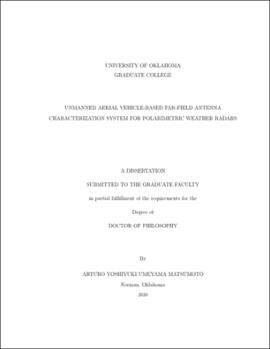| dc.contributor.advisor | Salazar Cerreno, Jorge | |
| dc.contributor.author | Umeyama Matsumoto, Arturo | |
| dc.date.accessioned | 2020-12-22T15:20:53Z | |
| dc.date.available | 2020-12-22T15:20:53Z | |
| dc.date.issued | 2020-12-18 | |
| dc.identifier.uri | https://hdl.handle.net/11244/326678 | |
| dc.description.abstract | The use of phased array radars for the US weather radar network (NEXRAD) has been proposed in lieu of the current mechanically steered dish-based systems, owing to its many attractive features, e.g., electronic steering and fast update rates, and others. Scatterer identification (hydrometeors and non-hydrometeors), accurate estimation of rainfall rates, and determination of propagation effects is possible in weather radars through polarimetry. However, the existence of cross-polarization, and co-polarization mismatch in the H- and V-polarization radiation patterns introduces biases in the polarimetric weather radar products, which can adversely affect the accuracy of the estimates of byproducts, thus imposing strict antenna requirements on the co-polarization mismatch of no greater than 0.1 dB, and cross-polarization levels of no greater than about -45 dB. Since the radiation characteristics of phased arrays are inherently dependent on the scanning direction, it becomes even more challenging to meet these requirements. Furthermore, ensuring that each system in this large network meets the requirements becomes an additional challenge where accurate characterization and calibration will be critical. Clearly, the system and instrumentation used for characterization also need to meet or exceed the system level requirements to provide reliable weather-radar-based estimates.
Given that radar and other communications systems require in-situ calibration, it is hypothesized that a UAV-based antenna measurement system is able to replace conventional outdoor ranges in virtue of its low cost and flexibility of operation. The proposed solution is a UAV-based in-situ antenna characterization system with the necessary RF instrumentation to perform accurate measurements of a typical weather radar, along with general guidelines and procedures to ensure optimal results. This solution attempts to provide a portable and cost-effective alternative to conventional outdoor antenna ranges, which can be deployed in multiple sites with few to no modifications. While previous works in the literature have had successful results in the use of UAVs for far-field (FF) antenna measurements in a variety of operating frequencies, no other work has currently shown the RF performance needed to meet the stringent requirements expected in an application such as polarimetric weather radars. It is shown in this work, that the characterization and calibration of real polarimetric weather radar systems is possible to a high degree of accuracy set forth by the most critical requirements, i.e., co-polarization mismatch no greater than 0.1 dB and cross-polarization levels below -45 dB. | en_US |
| dc.language | en_US | en_US |
| dc.rights | Attribution-NonCommercial-NoDerivatives 4.0 International | * |
| dc.rights.uri | https://creativecommons.org/licenses/by-nc-nd/4.0/ | * |
| dc.subject | Engineering, Electronics and Electrical. | en_US |
| dc.subject | Physics, Atmospheric Science. | en_US |
| dc.subject | Remote Sensing. | en_US |
| dc.subject | Engineering, Aerospace. | en_US |
| dc.title | Unmanned Aerial Vehicle-based Far-Field Antenna Characterization System for Polarimetric Weather Radars | en_US |
| dc.contributor.committeeMember | Fulton, Caleb | |
| dc.contributor.committeeMember | Palmer, Robert | |
| dc.contributor.committeeMember | Cheong, Boon Leng | |
| dc.contributor.committeeMember | Chilson, Phillip | |
| dc.contributor.committeeMember | Moghanloo, Rouzbeh | |
| dc.date.manuscript | 2020-12-08 | |
| dc.thesis.degree | Ph.D. | en_US |
| ou.group | Gallogly College of Engineering::School of Electrical and Computer Engineering | en_US |

